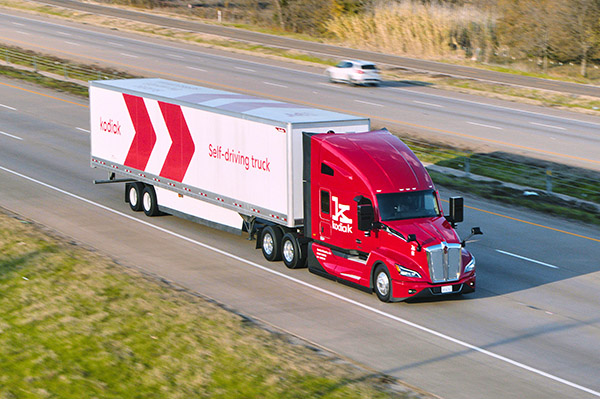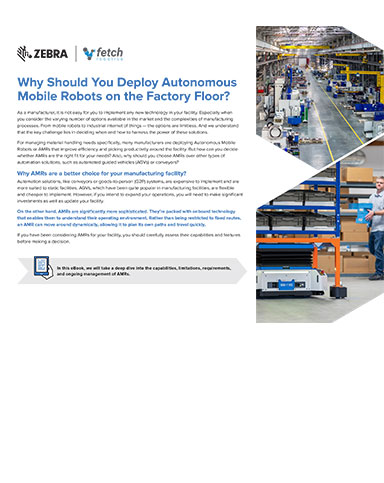Kodiak Robotics Moves, Adds Sensors to Fifth Generation Autonomous Truck
Kodiak Robotics has also removed the center sensor pod for faster build time and maintenance of its self-driving trucks.
Kodiak Robotics Inc. today introduced its fifth-generation hardware platform for autonomous trucks. The Mountain View, Calif.-based company said it has increased sensor redundancy and GPU processing power.
“Customers and OEMs aren't sensor experts, and they shouldn't have to be, which is why they constantly tell us they love our modular approach that solves one of the biggest barriers to servicing and maintaining autonomous trucks,” stated Don Burnette, founder and CEO of Kodiak Robotics. “We took a platform that our customers already love and made it better by adding more visibility, more power, and more flexibility, ultimately moving us closer down the path towards driverless deployment.”
Founded in 2018, Kodiak Robotics said it has developed a technology stack specifically for long-haul trucks to make the freight industry safer and more efficient. The company delivers freight daily for its customers across the South, operating autonomously on the highway portions of the routes.
Kodiak Robotics moves sensor pods to mirrors
Kodiak Robotics integrated its sensors into a streamlined “center pod” that it said was optimized for perception, scalability, and maintainability. The company has now removed that sensor suite and relocated the front-facing Luminar Iris lidar and wide field-of-view camera to each of its proprietary mirror-mounted SensorPods.
By integrating sensors into the SensorPods, and eschewing the “unibrow” sensor suite common in the autonomous trucking industry, Kodiak said it has made it easier for customers to refit their vehicles. The move also doubles the lidar coverage at long range of the Kodiak Driver self-driving technology, said the company.
By relocating the sensors to the SensorPods on the side-mounted mirrors, Kodiak said it has simplified the build process. They are now easier to reach, and customers do not have to access a truck's roof to maintain them, it said.
Roads are designed around a human driver's line of sight, and Kodiak said it has designed the SensorPods to be at the same height as a driver, improving perception and maximizing road safety. The SensorPods offer a dual vantage point, providing visibility on either side of the truck, as opposed to the single vantage point above the cab, it noted.
In the event of damage from a rock or another piece of debris, the redundant front-facing sensors increase resilience, claimed Kodiak. An on-the-fly replacement of the SensorPods can be performed in as little as 10 minutes, maximizing uptime and asset utilization, the company said.
A customer can then return a damaged SensorPod to Kodiak for evaluation and repair. The SensorPod is compatible with any truck platform, said Kodiak in a press release.
The company added that its modular hardware approach now includes fewer required modifications and touch points. This enables more cost-effective integration into trucks, it said, marking a significant step toward commercial deployment of Kodiak Driver.
“By removing the sensors from the top of the truck and incorporating them at a human driver's line of sight, we have designed a system for the real world,” said Burnette. “Additionally, having sensors on top of the cab is actually very difficult to service while on the road and requires specialized equipment, which is nearly impossible to find roadside.”
Sensor array designed for robustness
The fifth-generation truck improves upon the previous generation's sensor array, claimed Kodiak Robotics. In addition to removing the center pod, the company added a second forward-facing lidar and additional camera to add redundancy in the left and right SensorPods.
The number of onboard sensors has increased from 14 to 18, including one new lidar and three new cameras, bringing the total camera count to 10, said Kodiak. It also added two wide-angle cameras to the hood-mounted mirrors to cover blindspots.
“With the new sensor additions, Kodiak fifth-generation truck remains the most lean and fully-redundant platform in the industry,” asserted the company.
Kodiak's long-range sensor suite includes the following split evenly between the two side-mounted mirror SensorPods: f four ZF full-range radar for redundancy, two Hesai 360-degree scanning lidars for side- and rear-view detection, and two Luminar Iris sensors. It also includes eight cameras for both wide and narrow fields of view.
The new truck includes the recently announced Ambarella CV2 perception system on a chip (SoC), which handles all camera data processing. The Ambarella CV2 SoC improves image quality for longer-range detections and “unlocks” improved dynamic range for nighttime driving, said Kodiak.
“The modular nature of Kodiak's fifth-generation platform offers a unique approach to autonomy while also accommodating the demanding environment of long-haul trucking,” said Douglas Veatch, vice president of strategy at 10 Roads Express, a Kodiak customer.
“The thoughtful engineering of Kodiak's SensorPods makes the maintenance of a high tech machine much easier, which will help ensure greater uptime of our trucks,” he added. “This is a major differentiator amongst the autonomous trucking companies, and why we are working with Kodiak to incorporate their technology into our fleet.”
Kodiak improves hardware stack for performance
Kodiak Robotics said it has designed its hardware stack for three activities: sensing, through its SensorPods; thinking, through its main compute; and acting, which is controlled through two onboard custom-designed safety computers, the Kodiak Actuation Control Engine, or ACE.
The company also reduced the electrical power requirements for its fifth-generation truck while simultaneously improving the processing power of the system.
In addition to 130% more GPU processing power, the new system provides 60% more central processing power and additional redundancy, it said. The reduced power consumption allowed for a 50% reduction in the size of the fifth-generation power system, and it decreased cooling needs, said Kodiak.
Another example of Kodiak's modular approach to computing is how it simplified the integration of its system into trucks and making it easier to manage when they are incorporated into a customer's fleet. Kodiak has consolidated its in-house compute system, networking, and power distribution into one physical unit, which can be built to accommodate the unique specs of each customer, giving more options for integration.
Crystal Group, a manufacturer of ruggedized and military computers, makes Kodiak's high-performance compute hardware. The system and is designed to handle the heavy and persistent vibrations onboard long-haul trucks, said the companies.
Gen 5 truck includes military-grade tech
The fifth-generation truck also includes aerospace- and military-grade technology, Kodiak Robotics said. The company said the robustness of the main connector for data and power in its SensorPods and compute system is another step toward making it ready for deployment.
Like Kodiak's fourth-generation truck, the fifth-generation truck includes Cummins X15 Series engines and Bridgestone America's smart-sensing tire technology.
The company recently announced a 24-month U.S. Department of Defense project to help automate future U.S. Army ground vehicles. Advancements made within the scope of that project served as the foundation for the fifth-generation truck, it said.
Kodiak said the introduction of the new generation of its autonomy platform comes during a period of substantial growth. It recently announced partnerships with IKEA, Werner, Pilot Co., Forward, and more.
Article Topics
Kodiak Robotics News & Resources
Autonomous Trucking Continues to Build Momentum for Large Fleets Truckers Prepare For Era of Self-Driving Autonomous Trucks While Uber Exits Self-Driving Trucks Kodiak Robotics Starts Up Future of the Freight Supply ChainLatest in Supply Chain
Happy Returns Partners With Shein and Forever 21 to Simplify Returns S&P Global Market Intelligence’s Rogers assesses 2024 import landscape Frictionless Videocast: AI and Digital Supply Chains with SAP’s Darcy MacClaren Baltimore Opens 45-Foot Deep Channel Following Bridge Collapse Talking Supply Chain: Supply chain’s watchdog El Paso Border Delays Cost Juarez $32 Million Per Day in Economic Losses Ranking the World’s 10 Biggest Supply Chains More Supply Chain












